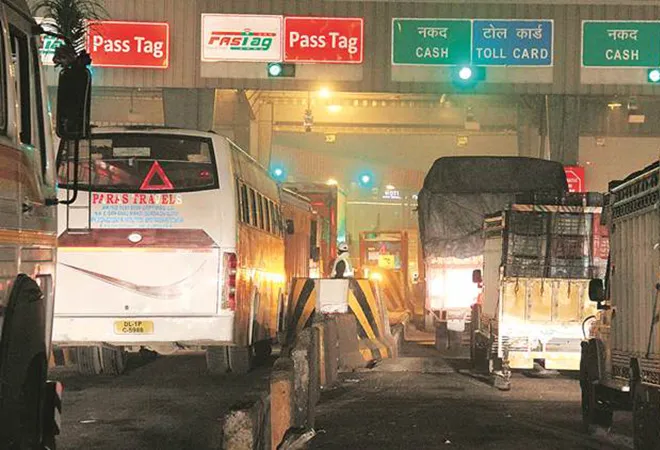
By 15 January 2020, every vehicle that passes through a national toll plaza will have to pay toll via FASTag. Unless the car has a FASTag, motorists will risk to pay a penalty of double the amount in cash when using the FASTag lanes, else stand in a long wait at the manual toll lane. In an effort to plug leaking revenues and generate rupees one lakh crore annually from toll collection in the coming years, National Highways Authority of India (NHAI) wants to shift to cashless, electronic processes and complete interoperability through a One Nation One Tag – FASTag.
Once completely implemented, the system envisions that as a vehicle with FASTag sticker nears the toll plaza, the gantry captures the sticker details and sends a toll request to its linked bank account. After the requisite amount of toll is deducted, the vehicle will be automatically allowed to pass through boom gates at the toll plaza. Thus, the new framework will have no stopping for the vehicle and no toll attendant involved. According to one study, this switch could save up to ₹ 12,000 crore nationally on fuel and person-hours. The new system paints a picture of vehicles zipping past toll booths; however, road users will find there are a lot of speed bumps that can slow you down till FASTag operations are fully streamlined across the country.
Currently, few toll plazas in the country have transitionary sticker reading mechanisms. Here, the toll booth attendant has to manually scan the toll tag on vehicles using a handheld or gantry-operated scanner. < style="color: #333399">Stopping the vehicle, ensuring it is indeed in the correct lane, searching for the toll attendant with the handheld scanner, not getting stuck behind a vehicle without the relevant sticker, is a game of probability that most vehicle drivers are playing in the country right now.
This article looks at some of the issues and possible guidelines that can ensure smooth implementation of the national toll framework.
- Getting states up to speed: There are several toll plazas on state or local highways which are not yet FASTag-enabled. Though states have signed agreements with the NHAI to transition to the national system, individual states have their own deadlines for implementation. To understand the spectrum of states’ readiness to transition to the new structure, the state of Maharashtra is looking at a possible 1 January 2020 deadline for implementation, Karnatakaand Punjab have announced implementation till mid-2020; while Himachal Pradesh is still unsure. Some states have an e-toll collection in place that they look to transition to FASTag; whereas others are relying on manual toll collection. For the latter, introducing electronic toll collection will entail investing in and setting up new scanners, boom gates and other road infrastructure. Through the MoUs signed between the states and the highways authority, the states’ will receive 50 per cent of the capex for the toll infrastructure construction. At this rate, it can be anywhere between six months to a year that the ‘One Nation-One Tag – FASTag’ scheme will be implemented and vehicle users can pass through toll plazas while the toll gets automatically deducted from their bank accounts.
- Toll plaza restructuring: The design, operations and working of the electronic and manual toll lanes will be key in increasing efficiency and reducing waiting time at the toll plaza. At the toll plaza, mismanaged, ill designed lanes or legacy lanes designed for manual toll collection will confuse both vehicles owners and toll operators. In some areas, police has been deployed for dispute resolution at the toll plazas. The toll plaza at the Bandra-Worli Sea-link in Mumbai is an example of a well-managed FASTag plaza. Like at the sea-link plaza, very clear signs of an approaching toll plaza, proper lane demarcation of electronic and manual lanes 500 meters to one kilometer before the toll plaza would help relieve the confusion in the initial months. A staggered traffic flow coming into the ‘slow’ or manual toll payment lane will help to keep the long queues and pile-ups at toll plazas under control. During the first few months, operating agencies will have to probably employ more people while the electronic toll implementation gets sorted out. As more toll plazas across the country become FASTag enabled, there could be possible pedestrian-vehicular conflicts due to different speeds at the e-toll and manual lanes. To minimise future conflicts, automatic speed display boards encouraging vehicles to slow down to a certain speed can be used. Other methods like pavement markings, lane channelisation, lane striping and impact attenuators can be used to ensure traffic management and lane discipline.
- Awareness for motorists: Since the past two months, the NHAI has been creating awareness among citizens about FASTag – its uses, benefits and even the ensuing penalties after the 15 January 2020 roll-out date. However, there is still an overall confusion about the use, operations and precautions while using the new system. Consumers may not be aware that different toll plazas will have different toll systems in place – manual, or state electronic toll or FASTag. Vehicle users will have to accordingly equip their vehicles for these arrangements.
- Security Concerns: Since FASTag is a stationary radio frequency identification device (RFID) sticker, vehicle users will have to be particularly wary of fraudulent transactions done using a ‘cloned’ Though the implementation mechanism has a robust architecture, the onus is on users to report multiple or fraudulent transactions to the banking partner immediately. The user also needs to maintain adequate balance in the bank account for a toll request to be accepted and processed by the bank. Unless this is done, the tag may get blacklisted – the user then has to pay cash for the toll fee. Once the FASTag is backlisted, the motorist will have to contact the issuing agency and take steps to remove this blacklisting. Currently, the bank issued tags are linked to a prepaid e-wallet by the issuer banks and are non-transferable between banks or e-wallets. The NHAI issued tags are not linked to any bank.
Though this is a well-intentioned and much-needed intervention, an unplanned and hasty implementation will only increase the completely avoidable confusion and worsen – not improve – traffic woes for several months till such time the operations are streamlined country-wide.< style="color: #333399"> Getting states on board, involving toll plaza operators and administration and informing the consumers on new and ongoing changes will help the nation transition smoothly to FASTag. These guidelines need to be disseminated to concerned stakeholders – state highway authorities, toll plaza operators, administration agencies, concessionaries, and banking partners and consumers. The NHAI can do this through stakeholders’ workshops, online and in-person consumer awareness programmes, and other means of communication. This will enable to streamline and standardise the process of bringing stakeholders on board and will enable to ensure the setting up of a nationwide, interoperable FASTag system that will be beneficial for the consumers and government alike. < style="color: #333399">A nationally interoperable toll collection system would pave the way for future road reforms, like intelligent traffic monitoring systems (ITMS), dedicated lanes for public transport and congestion pricing on heavily congested urban roads.
The views expressed above belong to the author(s). ORF research and analyses now available on Telegram! Click here to access our curated content — blogs, longforms and interviews.

